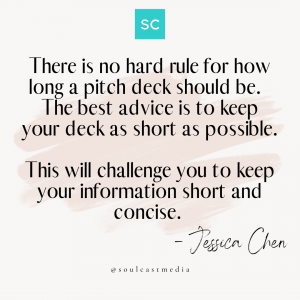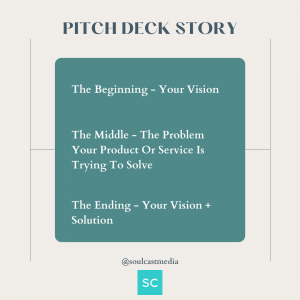What Your Pitch Deck Should Include
When pitching to investors you will want to include a pitch deck. A pitch deck is a brief presentation, such as PowerPoint slides, that gives an overview of your business.
Before you create your pitch deck, it is important to understand the role the deck plays.
The pitch deck is there to enhance your pitch to investors and should be visually interesting.
Too many words aren’t visually interesting. It is important to keep text to a minimum. So what should your pitch deck include? Below we’ve put together a few guidelines to help you as you create your business pitch deck.
1. Length
There is no hard rule for how long a pitch deck should be. There are some very successful decks that are as short as three pages. On the other hand, there are some that are 15 slides long.
The best advice is to keep your deck as short as possible. This will challenge you to keep your information short and concise. You often don’t get many chances to pitch your idea. Don’t let your investors get lost in excess words.
2. mission-related pages
Your pitch deck should give a strong overview of what your company is about. This should be started with mission-related paged. For example:
Vision Page – This is the page that showcases your value to consumers and society. Try and define your vision in under three sentences.
Problem Page – You will also want to include a page that explains the problem you are trying to solve. A good way to know if you are doing this right is to ask yourself, how can I explain my company solving this problem to a fourth-grader? It sounds silly but it will force you to think about the problem and your solution more simply. Once you have defined your problem, this is where you introduce your product or service that’s meant to solve it.
Again, as you create your deck, be very careful about what you include. Less is more.

3. Visuals
Your pitch deck should be very visually appealing, which means you will want to include as many visuals as possible to illustrate your points. Examples of visuals you can include in your pitch deck:
Photographs – Using striking images to make your point will help your investors understand your vision.
Data Images – Pie charts and graphs that showcase data are visuals that can help show investors how your product performs. For example, if you’ve tested your product against the competition and your product is 10% more efficient and 25 % more effective, you’ll want to include that as a visual graph or animation for more impact.
Videos/Video Clips – If you are presenting a digital deck, you can use video and video clips to showcase your product/service or evoke an emotion from your investors. For example, if your product solves a problem for families – getting a short testimonial can help not only tell your story but show your product working in real life.
4. Tell A Story
Use your deck to try and tell a story. A pitch deck should have three parts, beginning, middle, and end. This story should have a human element. Meaning, there has to be some heart. Problem is, not everyone knows how to tell a story in a way that captures attention, and that’s okay!
 Investors are drawn to stories that show passion.
Investors are drawn to stories that show passion.
Vision – The easiest place to tell your story is starting with your vision. This can be part of your why. What compelled you to start your business? Take the investor to a specific place and time.
Problem – Chances are what compelled you to start your company was because of a problem you faced. Be sure to include emotional language of how frustrated or inefficient things were before.
Solution + Vision – The ending of your story should include the solution and vision combined. This is also where you can talk about tangible results and how you plan to increase your impact.
Your story is powerful. Don’t shy away from talking about it
5. Flexibility
The key to creating any pitch deck is to remain flexible. As you share this deck with different investors, you may also have to change things depending on what you know about them. For example, if the investors like shorter decks, be sure to shorten your deck to their preference.
Personalizing your deck for investors, though time-consuming, can often pay off. The investor will feel like you are doing your homework when you personalize it for them.
You may also encounter a time when the deck may be viewed separately. This means you aren’t physically in the room or even on video when the investors look through your deck. This can happen if the investors ask to see your deck before your meeting. If this happens, be mindful of how you construct your deck knowing that you won’t be there to explain what’s inside.
As you can see, there isn’t one hard rule when constructing your pitch deck. The key is to keep your deck visually interesting while keeping your focus on your message and goal.
__
Whenever you’re ready, there are 3 ways we can help you:
- Discover your communications style so you know where to start. Over 4,000 people have found theirs here.
- Attend our monthly communication workshop to build communications confidence (new topics: public speaking, advocating for yourself, building credibility, etc) here.
- Get your brand in front of 43k+ people by sponsoring our newsletter or Soulcast Media | LIVE LinkedIn events [contact: hello@soulcastmedia.com]











